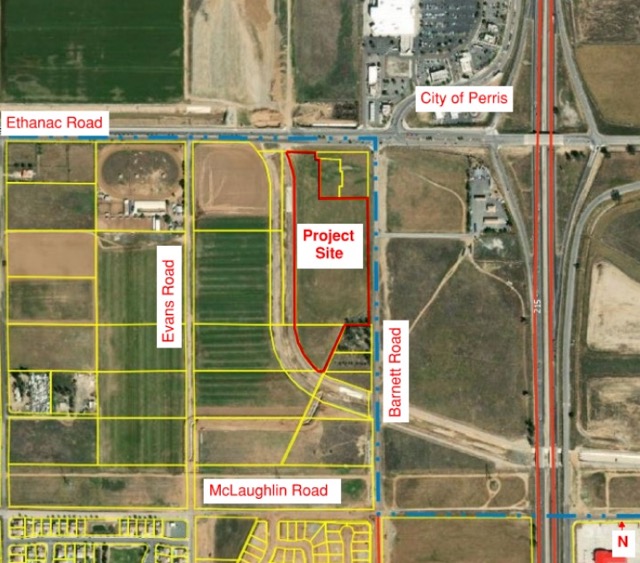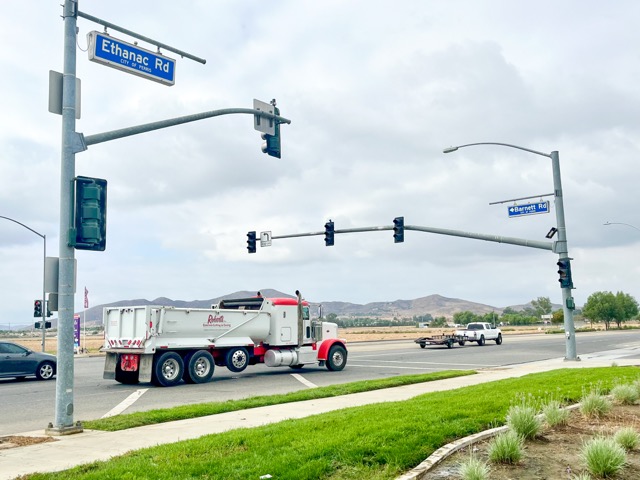Border Dispute
By Jim Forbes, Publisher
When rapidly growing, adjoining cities have developed “best-laid plans” for their citizenry, but their respective visions conflict with each other, and are only separated by a four-lane road…
Well, then you have trouble. With a capital “T” that rhymes with “P”, which stands for Perris.
Perris, to the north, envisions its south side, as a haven for residential and supporting commercial and retail development. It is more than a vision, it’s a developing reality with the city’s “Green Valley Specific Plan.”
Menifee, to the south, envisions its north side to be swell for commercial development such as warehouses and manufacturing, specifically the “Ethanac and Barnett Development Project.”
Between the two concepts is Ethanac Road, to the west of I-215.
The rub is the potential of homeowners and shoppers exiting the 215 at Ethanac heading to Perris on the north side and semis doing the same while heading to Menifee on the south side. And, of course, the opposite, as the traffic is heading from the neighboring cities onto Ethanac, to climb onto the 215.
The issues are multi-fold, including environmental impacts, traffic congestion, construction and the competing interests of quality of life and commerce.
Not surprisingly, the cities have filed suit against each other in the last two years, and the civil actions are wending their way through the Riverside Superior Courts.
In its suit, Perris maintains that Menifee’s analysis is lacking and that further environmental reviews are warranted. One specific Perris argument is that Menifee does not take into account the planned future development on the Perris side.
Judge Harold W. Hopp has been considering a number of competing arguments, from traffic congestion to vehicle emissions to noise pollution. His ruling issued last week found in favor of both sides, depending on the issue, resulting in both cities claiming a measure of victory.
Finding in favor of Perris on the issue of traffic, the court ruled, “…the Project will, increase of (sic) semi- truck traffic in the area. While Menifee claims the increase is essentially negligible, this response does not overcome Perris’ fair argument that theintersections may result in significant traffic safety impacts, which is supported by substantial evidence and must be analyzed under CEQA” (the California Environmental Quality Act.).
Hailing the court decision, the City of Perris issued a statement that reads in part, “…the City of Menifee will now be required to set aside the project approvals and comply with the California Environmental Quality Act (CEQA) before reapproving the project and ensure adequate traffic safety improvements are included in the project.”
The net effect is overturning the existing approval of the project and hitting the pause button until the traffic congestion issue is studied further under CEQA guidelines.
In its own released statement, the City of Menifee writes, “While the City is disappointed in the court’s decision to overturn the approval of the project, it does not prevent the project from ultimately moving forward.”
In all other matters of dispute, the court ruled in favor of Menifee.
“Menifee correctly argues that impacts must be measured on the existing community, not a speculative future environmental condition, such as the development of a residential community in the GVSP.” (Green Valley Specific Plan)
The court continued, “For the foregoing reasons, the petition is granted as to the Traffic Safety Impact issue only. Petitioner to prepare a proposed order and writ.”
Perris will now craft the “writ,” the language for the court to approve regarding the traffic safety impact in compliance with CEQA, and Menifee has 60 days from the ruling to file an appeal, should it wish.

For More Perris News Visit www.zapinin.com/perris


